Stars Wars Rogue Leader: Rogue Squadron II Preview
We got a good look at this breathtaking piece of software. Read all about it.
The original Star Wars trilogy couldn't have come at a worse time for console gamers. While arcade games based on the classic series managed to capture bits of the trilogy's magic, the home console offerings required a hefty dose of imagination on the part of the players. The old Atari 2600 just wasn't up to the task of selling the battle between the Imperial Walkers and snowspeeders from The Empire Strikes Back or the Death Star Battle from Return of the Jedi. Things perked up in the 16-bit era with the SNES Super Star Wars games, thanks to tight gameplay, detailed graphics, and great sound. But as good as the games were back then, there were compromises due to the limitations of the hardware. The storytelling and gameplay in the games crammed the movie narrative into the constraints of a polished platformer with some vehicle-piloting segments. Such compromises became things of the past when LucasArts and Factor 5 double-teamed the Nintendo 64 in 1998 with Star Wars: Rogue Squadron. Focusing on the vehicle segments that had been fan favorites in Shadows of the Empire before it, Rogue Squadron showcased detailed graphics, excellent sound, addictive gameplay chock full of replay value, and an immersive feel that came the closest to capturing the spirit of the films on a home console. After a three-year wait, fans of the original Rogue Squadron who've ached for a follow-up to one of the N64's best games are in for the mother of all treats as Factor 5 brings the sequel, Rogue Leader: Rogue Squadron 2, to the GameCube in a flurry of blaster fire that sets an impressive standard for both Star Wars games and GameCube titles at large.
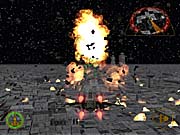
President of Factor 5 and director of Rogue Leader, Julian Eddebrecht, and Rogue producer, Brett Tosti, practically glow with pride when they talk about the game and how it further refines elements found in the company's early efforts. The narrative structure in Rogue Leader is a definite improvement over the original: It offers a better flow to the story and still holds true to how Factor 5 told the story in Star Wars Episode 1: Battle for Naboo. In that game, you experienced events from the perspective of a character that was part of the resistance to the Trade Federation invasion, which was briefly mentioned in the film. The creative license let Factor 5 include levels directly lifted from the film, along with original ones, while maintaining a much more cohesive narrative than the original Rogue Squadron. Pleased with the results from Naboo, Factor 5 opted to use the same approach in Rogue Leader. Using the main narrative of the trilogy as a touchstone, Rogue Leader tells the story of how the legendary Rogue Squadron was formed. Given the squadron's pivotal role in the trilogy, Factor 5 is able to offer a great mix of old and new. Starting out with the attack on the Death Star from Yavin, you'll find yourself taking the role of Luke Skywalker in Red Squadron. In the wake of the Death Star's destruction and the loss of Red Squadron's leader, Rogue Squadron is formed, at which point the game then puts you in the role of Wedge, seen to be the leader of Rogue Squadron in Return of the Jedi. In a move typical of Factor 5's attention to detail, Denis Lawson, the actor who portrayed Wedge in the films, was tapped to record voice for the game. As Wedge, you'll find yourself playing through most of the familiar battles from the films, and you'll take on some original missions that probably happened off camera in the movies. For example, following the Death Star attack over Yavin, you'll find yourself escorting a convoy of Rebel ships from Yavin to Hoth as the base is moved.
Fans of the original Rogue Squadron will feel right at home with Rogue Leader, as the game's structure will closely follow the original game's objective-based missions and medal earning. You'll still select your missions from a war room that lets you cycle through available ones. Once you select a mission, you'll find yourself in a hangar near the ship that you'll be using. While you'll only have access to one fighter type for each mission at the beginning of the game, more ships become available as you progress through the game and can be used to replay previously cleared levels. You'll eventually find yourself in an X-Wing, Y-Wing, A-Wing, B-Wing, and snowspeeder.
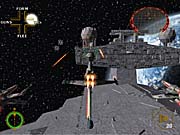
During the game, you'll also have the opportunity to switch between a Twin Pod Cloud Car and an Imperial Shuttle in certain levels. Once in the cockpit of your craft, you'll find that piloting a spacecraft is surprisingly user friendly. The HUD keeps the clutter to a minimum, basically offering the same information as Rogue Squadron did: a radar display, a shield indicator, and a number of missiles are all onscreen to keep you well informed. Factor 5 has slightly tweaked the control scheme of the original to take advantage of the GameCube controller. You'll move your fighter with the analog pad and use the C stick to rotate the camera. Acceleration is done via the right trigger, and braking is done via the left trigger.
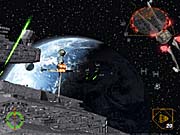
In a nice use of the GameCube controller, the secondary buttons on the triggers are used as well. After you've pulled down on either trigger you'll feel resistance, when you fully depress them you'll hear a "click," allowing them to be used as buttons as well. Clicking the brake button will slow your fighter, while the accelerate button will shoot your fighter off at high speeds, preventing you from firing until you brake. The A button shoots your primary weapons while the B button fires torpedoes, toggles the Y-Wing's bombing mode, or uses the snowspeeder's tow cable, depending on your craft. A small onscreen meter around your shield display reflects the firing mode of your primary weapons. When full, pressing the A button releases a concentrated burst of blaster fire, while holding down the fire button after an initial shot results in a constant spray of fire. The X button calls up your ship's targeting computer, resulting in a screen overlay that highlights targets. More than just a cool effect, the targeting computer is an extremely useful part of the game as it highlights and categorizes targets. Mission-critical targets are displayed in yellow while secondary targets are shown in lavender. Given the game's speed and the size of some of the areas, you'll find yourself overwhelmed unless you rely on the computer. While it may not be very Jedi-like to rely on a targeting computer, it's a necessary thing for Force-challenged fans piloting an X-Wing. The Y button cycles through the inside and outside camera views, and while there are only two, you can get a better view of the action by using the C stick. In another nice touch, the information from the HUD seamlessly blends in with the inside of the cockpit. The Z button will let you perform rolls in your ship, which just looks cool.
Adding a nice bit of immersion to the game, the controller's D-pad will let you interact with a variety of NPCs (nonplayable characters) during a mission.
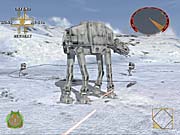
Over the course of a level, you'll be contacted by any number of characters, such as your wingmen, your R2 unit, or ground troops you encounter. When this happens, a cross display will show up in the upper right-hand corner of the screen with commands in each direction on it. You'll select a response by pressing the D-pad in the direction of a command. Your R2 unit will offer to repair parts of your ship in combat. Ground troops will ask for orders when you fly close enough to them; for example, it's possible to order your troops to take on AT-STs on the Hoth level. The commands can also change according to events within the level. For example, if you haven't completed an objective in a level, such as destroying all turrets, you'll be able to get your wingmen to help. However, if you have completed your objectives, other options will be present. It's even possible to have your wingmen target a specific enemy, such as one TIE fighter in a squad, during battle. Finally, the start button will pause the game and display a list of the objectives that must be completed in order to clear the level.
In addition to the character interaction mentioned, another factor contributing to the game's immersiveness is its AI. This time out, you may find yourself sweating a bit more as TIE fighters break formation when they're attacked and try to circle around you for a clean shot. While this can be a pain in open space, it works to your advantage in the enclosed area of the trench, as the TIEs will slam into nearby walls when one of their comrades goes up in smoke.
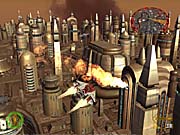
When circling an AT-AT in your speeder with a tow cable, you'll see the main guns in the head slowly try to get a bead on your craft while you weave through its legs. To balance things out, your wingmen and ground troops react appropriately to threats and can offer fairly useful support in combat.
Another major contribution to Rogue Leader's immersiveness is the in-game music and the wealth of sound effects taken straight from the film. Everything from the hum of your engines to the mechanical sound of AT-ATs walking is true. Thanks to the GameCube's sound chip, Rogue Leader's audio is looking to be top-notch. John Williams' classic score is dynamically blended with original tracks on the fly during the game. As mentioned, the various sound effects in the game are spot on, and in a nice touch their pitch shifts, depending on the camera view. For example, when inside the cockpit the engine noise is more prominent, while the outside view emphasizes weapon fire. Audiophiles will be ecstatic to hear the game's 5.1 stereo sound, even during gameplay, on their home entertainment centers.
While the gameplay and sound in Rogue Leader are coming along beautifully, what has brought it the most attention has been its graphics. In speaking with Eddebrecht and Tosti, we were surprised to hear that the work done for the footage shown at Spaceworld was completely thrown out. Put together in just 19 days on an early development kit, the Rogue Leader teaser shown was never intended for use in the game. Instead, Factor 5 began development on this new version in January and has made some serious improvements on what was shown last year and even what was recently shown at this year's E3. Making use of absolutely no CG, Rogue Leader uses nearly every special effect the GameCube has to offer, including bump mapping, reflection mapping, particle effects, aliasing, and cel shading for amazingly detailed graphics.
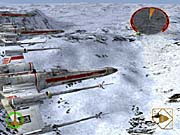
In addition, volumetric enhancements to effects, such as shading and fogging, give shadows and clouds truly realistic appearances. The aforementioned effects are on top of the game's generous poly count for in-game objects. The various Rebel fighters you will pilot are made up of roughly 15,000 polygons, while enemy fighters start at 3,000 polygons and can be as high as 130,000 polygons, such as in the case of the Star Destroyer you encounter. The detail on nearly everything you see in the game is truly impressive; everything from the subtle weathered look of the X-Wings to the incredibly smooth look of Bespin is there to see. Factor 5's attention to detail is clearly reflected by the sick detail shown in the cockpit view: The ship interiors are perfectly re-created and can be marveled at by using the C-stick to look around (although it's not a great idea to do so when in the middle of a firefight). Even the hangars in the game change depending on where you're launching from: You'll leave from the Yavin base hangar in your first battle against the Death Star, but later levels will have you leaving from the Mon Calamari cruiser's hangar, each perfectly recreated. Rogue Leader's real-time lighting helps to sell the game's look, as it allows for subtle shadows and helps to simulate clouds moving in the sky as time passes. The GameCube's graphic muscle also ensures a very smooth in-game camera, as it shifts from perspective to perspective, such as when the targeting computer interface comes up. Displayed by using a form of cel shading, the targeting computer switches on and off with no hitch in gameplay or camera. When an enemy fighter targets your craft and is on your tail, the camera pulls back far enough to actually let you see the ship behind you.
The onscreen action is made all the more impressive thanks to the blistering speed on display. Factor 5's goal is to have Rogue Leader run at a constant 60 frames per second. At present, it looks as though the goal is attainable--all the E3 demo levels currently run at a constant 60fps in spite of the addition of lighting effects that have significantly improved their look. When asked how many polygons the GameCube is pushing in Rogue Leader, Tosti offered a rough estimate of 150,000 polygons per frame or roughly 9 million polygons a second.
In addition to being allowed to play through the newly freshened E3 levels, we were allowed to get a glimpse of an early Hoth level, which was very cool. Perfectly re-creating the Imperial attack on the Hoth base, the level begins with you piloting a snowspeeder. After a brief bit of target practice with a pack of Imperial Probe Droids, you'll fly over a ridge and find yourself right in the middle of the battle between Rebel ground forces and Imperial Walkers. Ground troops from both sides--each composed of 300-400 polygons that are fully lit and shaded--advance on each other as you fly over. Smoke from smoldering radar laser cannons parts as your speeder flies through, dodging fire from AT-STs. Using the speeder's tow cable, it's possible to take out AT-ATs like in the films and earlier games. Fortunately the interface has been much improved, leaving much less room for user error: Basically you just steer using your speeder's shadow as a guide to keep from slamming into the walker's legs.
When a walker is brought down, the game offers a real-time cutscene of it falling. Factor 5, in fact, hopes to include a variety of "death" animations in the game, to keep things fresh as you go through.
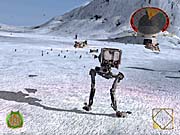
If the Ion Cannon is kept safe and the walkers are destroyed, you will head over another ridge and see a line of Rebel transports prepping for take off. A quick ship change to an X-Wing later, and you'll then be doing guard duty for the transports as they head out, escorted by X-Wings amid cover fire from the Ion Cannon just like in the film. While the Hoth level was missing some particle effects and hadn't been optimized yet, it showed a great deal of promise and left us hungering for more.
As an added treat, we were able to play the game with what we were told was the final retail GameCube controller, as well as a prototype Wavebird wireless controller, which had just arrived at Factor 5. The one noticeable difference in both controllers from what we've seen before is the B button, which is now oval shaped like the Y and X buttons. The Wavebird also lacked the corded controller's built-in rumble feature. We're pleased to report that both controller types handled extremely well with the game. The various ship functions and camera controls were a breeze to toggle through. Using the D-pad to give orders took a bit of adjustment but felt very natural after a few minutes flying around in the game.
While we were able to see a selection of levels from Rogue Leader that gave us an idea of what to expect from the game, they were just a taste of what's to come. Factor 5 currently hopes to include a total of 11 levels--plus bonus levels that you can be purchase with medals that you earn while playing. In addition, Tosti hinted at the possibility of hidden craft in Rogue Leader. So far, Rogue Leader is shaping up to be a most impressive launch title for the GameCube and a truly stellar Star Wars title for the home. Gamers would do well to check it out this November when the GameCube launches. Our thanks to Julian Eddebrecht and Brett Tosti for making time for us.
Got a news tip or want to contact us directly? Email news@gamespot.com
Join the conversation